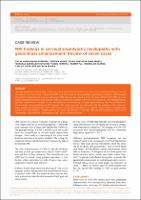Resum
Paraules clau
Ressonància magnètica; Mielopatia espondilòtica cervical
Citació recomanada
Pessini Ferreira LM, Auger C, Kortazar Zubizarreta I, Gonzalez Chinchon G, Herrera I, Pla A, et al. MRI findings in cervical spondylotic myelopathy with gadolinium enhancement: Review of seven cases. BJR Case Reports. 2021 Jan 5;7:20200133.
Audiència
Professionals
Empreu aquest identificador per citar i/o enllaçar aquest document
https://hdl.handle.net/11351/6603Aquest element apareix a les col·leccions següents
- HVH - Articles científics [2958]
Els següents fitxers sobre la llicència estan associats a aquest element:


